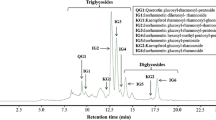According to the literature, iron chelators have been used to inhibit tumor cell proliferation. Hydroxypyridinones, due to easy derivatization and high affinity for iron, have been suggested as an attractive target for the development of iron scavenging ligands. N-arylhydroxypyridinone derivatives as iron chelators have been previously designed and synthesized, and the present study is performed in order to evaluate the antitumor efficacy of these compounds,. Four derivatives of hydroxypyridinone were tested against HCT116 and SW480 colon cancer cell lines for 48 h using MTT assay. One compound (3-hydroxy-2-methyl-1-phenylpyridin-4(1H)-one, PMPO) showed the maximum cytotoxic activity on both HCT116 and SW480 cancer cells with IC50 = 243 and 180 μmol, respectively, for 48 h treatment. The obtained results demonstrated that various concentrations of test compounds exhibited significant reduction of the cell viability (P < 0.05) in a concentration dependent manner. Our findings indicate that the proposed hydroxypyridinone derivatives can be considered as a new option for the treatment of colon cancer.


Similar content being viewed by others
References
N. El-Ebiary, R. Swellem, and G. Nawwar, Pharm. Chem. J., 51(1), 39 (2017).
K. Deepti, K. R. Amperayani, N. S. Yarla, and U. D. Parimi, Pharm. Chem. J., 51(4), 295 (2017).
V. Shirinyan, A. Markosyan, M. Baryshnikova, et al., Pharm. Chem. J., 51(10), 867 (2018).
A. Pirpour Tazehkand, M. Akbarzadeh, K. Velaie, et al., Biomed. Pharmacother., 103, 755 (2018).
D. Sun, W. Shen, F. Zhang, et al., Biomed. Pharmacother., 101, 107 (2018).
R. A. Smith, K. S. Andrews, D. Brooks, et al., CA Cancer J. Clin., 67(2), 100 (2017). doi:https://doi.org/10.3322/caac.21392
A. Banerjee, S. Pathak, V. D. Subramanium, et al., Drug Discovery Today, 22(8), 1224 (2017).
S. J. Dixon and B. R. Stockwell, Nat. Chem. Biol., 10(1), 9 (2014).
B. Keeler, M. Brookes, Brit. J. Pharmacol., 168(6), 1313 (2013).
D. Richardson, Crit. Rev. Oncol. Hematol., 42(3), 267 (2002).
S. Vogel, D. Kaufmann, M. Pojarová, et al., Bioorg. Med. Chem., 16(12), 6436 (2008).
S. Chaves, L. Piemontese, A. Hiremathad, and M. Santos, Curr. Med. Chem., 25(1), 97 (2018).
M. Borzoei, M. A. Zanjanchi, H. Sadeghi-aliabadi, and L. Saghaie, Food Chem., 264, 9 (2018).
M. Borzoei, M. A. Zanjanchi, H. Sadeghi-Aliabadi, and L. Saghaie, Biol. Trace Element Res., (2019) [in press].
D. Arduino, D. Silva, S. M. Cardoso, et al., Front. Biosci., 13, 6763 (2008).
N. Mobarra, M. Shanaki, H. Ehteram, et al., Int. J. Hematol. Oncol. Stem Cell Res., 10(4), 239 (2016).
L. Saghaie, M. M. Sadeghi, and A. Nikazma, Res. Pharm. Sci., 1(1), 40 (2007).
A. Fonseca-Nunes, P. Jakszyn, and A. Agudo, Cancer Epidemiol. Prevention Biomarkers, 23(1), 12 (2014).
S. V. Torti and F. M. Torti, Nat. Rev. Cancer, 13(5), 342 (2013).
L. M. Bystrom and S. Rivella, Free Radical Biol. Med., 79, 337 (2015).
A. Curnow, B. Mcllroy, M. Postle-Hacon, et al., Brit. J. Cancer, 78(10), 1278 (1998).
S. P. Foy and V. Labhasetwar, Biomaterials, 32(35), 9155 (2011).
M. Fryknäs, X. Zhang, U. Bremberg, et al., Sci. Rep., 6, 38343 (2016).
D. T. Puerta, J. A. Lewis, and S. M. Cohen, J. Am. Chem. Soc., 126(27), 8388 (2004).
G. Coombs, A. Schmitt, and C. Canning, Oncogene, 31(2), 213 (2012).
S. Song, T. Christova, S. Perusini, et al., Cancer Res., 71(24), 7628 (2011).
Author information
Authors and Affiliations
Corresponding author
Ethics declarations
There are no potential conflicts of interest for each author concerning the submitted manuscript.
Rights and permissions
About this article
Cite this article
Sadeghi-Aliabadi, H., Zanjanchi, M.A., Saghaie, L. et al. Evaluation of the Cytotoxic Effect of Hydroxypyridinone Derivatives on HCT116 and SW480 Colon Cancer Cell Lines. Pharm Chem J 53, 388–391 (2019). https://doi.org/10.1007/s11094-019-02010-2
Received:
Published:
Issue Date:
DOI: https://doi.org/10.1007/s11094-019-02010-2




